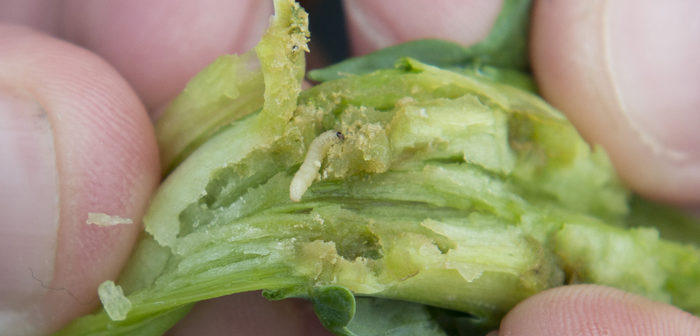Oilseed rape growers and agronomists can now calculate the optimum timing to target cabbage stem flea beetle larvae hatch, with the chance to limit stem infestation.
Dr Max Newbert, Syngenta technical manager, reports that female cabbage stem flea beetle (CSFB) typically start egg laying in soil around the base of OSR plants two weeks after migrating into the crop. Larvae then emerge after 240 degree days (DD), before crawling up the stem and burrowing into leaf petioles.
“The aim is to target Hallmark Zeon sprays during the key period of larvae movement,” he advised. Trials have shown that a well-timed application can have a good effect in limiting initial infestation, with a 0.3 t/ha yield advantage.
Growers can identify migration dates for CSFB into crops from results of water trap monitoring. From that, it is possible to make a prediction of egg hatch and larvae movement, based on historical weather data or, ideally, in field weather station information for the current season, advised Dr Newbert.
Degree Days, for CSFB, can be calculated by taking a site’s daily high temperature, plus the low, dividing by two and subtracting a base of 3.2°C – the point at which CSFB larvae stop emerging. If the high was 16°C and the low 6°C, the calculation would be (16 + 6) ÷ 2 – 3.2 = 7.8 DD. More advanced DD calculators work on the same basis, but assessing hourly temperatures.
At the Syngenta iOSR site, near Letton, Norfolk, for example, CSFB migration commended in earnest on September 8th, with egg laying from September 21st. Therefore, using DD data of last year’s temperatures, the earliest timing of Hallmark Zeon treatments to target larvae would be October 13th.
“It is important to recognise that in warmer conditions larvae will emerge sooner, but if conditions turn cooler that would be delayed. It would also be different for locations across the UK. Application timing needs to be tailored accordingly,” he advised.
Recommended tthresholds for treatment are currently five larvae per plant or 50% of petioles with scaring. However, research on the iOSR site has shown larvae numbers can increase very rapidly, with in excess of 40 larvae per plant frequently recorded – with a serious impact on the crop.
“The earlier the infestation, the greater the degree of damage on the plant,” pointed out Dr Newbert. “In mild autumn conditions adults will continue to lay eggs and new larvae continue to emerge whilst temperatures are above 3.2°C. With warmer winter weather we have seen egg laying continue into February or March.
Dr Newbert added that CSFB larvae sprays could also coincide with egg laying activity of rape winter stem weevil, which is especially prevalent and damaging in northern areas.
“Unlike the CSFB, weevil lay their eggs straight on to the leaves, where emerging larvae burrow down into the stem,” he commented. “Therefore, the target has to be to control the adults in their four-week feeding period, prior to the onset of egg laying. That is typically towards the end of September and through October.”





